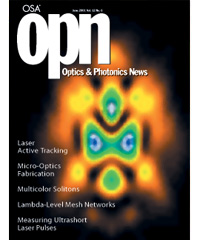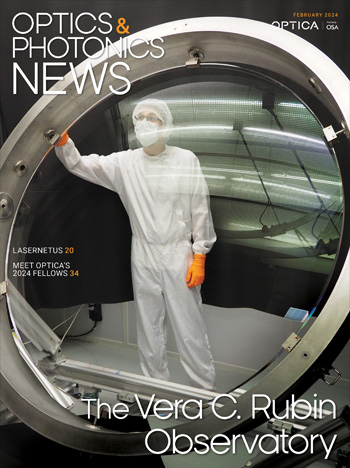Feature Articles
Measuring Ultrashort Laser Pulses Just Got a Lot Easier
In the past decade, great advances have occurred in the field of ultrashort-pulse measurement. New classes of more powerful methods now yield much more information, in particular, the full intensity and phase of the pulse vs. time. But simplicity has never been the goal. In fact, these new techniques have actually increased in complexity. They all incorporate an autocorrelator and add additional components—sometimes a great many of them.
by Rick Trebino, Patrick O’Shea, Mark Kimmel, and Xun GuLaser Active Tracking
Although in many laboratory settings, standard mirrors and lenses will serve to train laser beams, other applications require unprecedented pointing accuracy or remote pointing control. In California, where movies are big business, optical trackers are being considered as an aid to smooth camera panning while tracking fast action scenes.
by P. M. LivingstonMicro-Optics Fabrication by Ink-Jet Printers
It may be concluded from the advances achieved to date in the development of optics-jet technology that the microjet printing method of micro-optics fabrication provides the potential for reducing costs and enhancing assembly process integration in a number of optoelectronics manufacturing applications.
by W. Royall Cox,Ting Chen, and Donald J. HayesMulticolor Solitons
The fascination and importance of multicolor solitons is twofold. For one, they offer a truly unique laboratory for soliton phenomena: multicolor solitons exist in the spatial and the temporal do- mains; they exist in guided and in bulk media; they exist in any physical dimensions and thus have the potential to form three-dimensional light bullets; they exist in continuous as well as in discrete physi- cal settings; and they are the realization of a universal phenomenon in nature, name- ly, the nonlinear parametric mixing of waves. Second, multicolor solitons offer clean, robust, stabilized, particlelike pulses. These beams could play key roles in future passive or active, single-pass or cavity, multifrequency photonic devices for which the price of operation at high-peak power is offset by the unique features of the soliton light spots.
by Lluis Torner and George I. StegemanLambda-Level Mesh:Logical Evolution of the Optical Transport Network
Optical networks have passed through several stages of evolution. The initial stage, point-to-point networks, was driven by the need for connectivity and for building experience with a new medium. As experience levels grew, the need for redundancy was quickly identified. This need was satisfied through the Synchronous Optical NETwork/Synchronous Digital Hierarchy (Sonet/SDH) protocols by implementing physical rings across the fiber network. While effective, this architecture has proven to be awkward and expensive when deployed on a large scale due to the requirement to reserve bandwidth for restoration and the “shared medium” nature of a ring (all points on the ring must share a finite amount of bandwidth). Due to the fundamental constraints induced by the ring architecture, the need to move to a mesh network, in which each element is connected to some or all of the other network elements, has surfaced. While it is a very effective mechanism for allocating the required amount of bandwidth between any two nodes, this approach suffers from the requirement that a large number of fibers be connected to each node and by limited restoration capabilities.
by Elon Littwitz

![A multiplexed image of a human tonsil acquired. [NIAID] using the iterative bleaching extends multiplexity (IBEX) method.](https://opnmedia.blob.core.windows.net/$web/opn/media/images/articles/2024/0424/departments/202404-cover-web.jpg?ext=.jpg)

